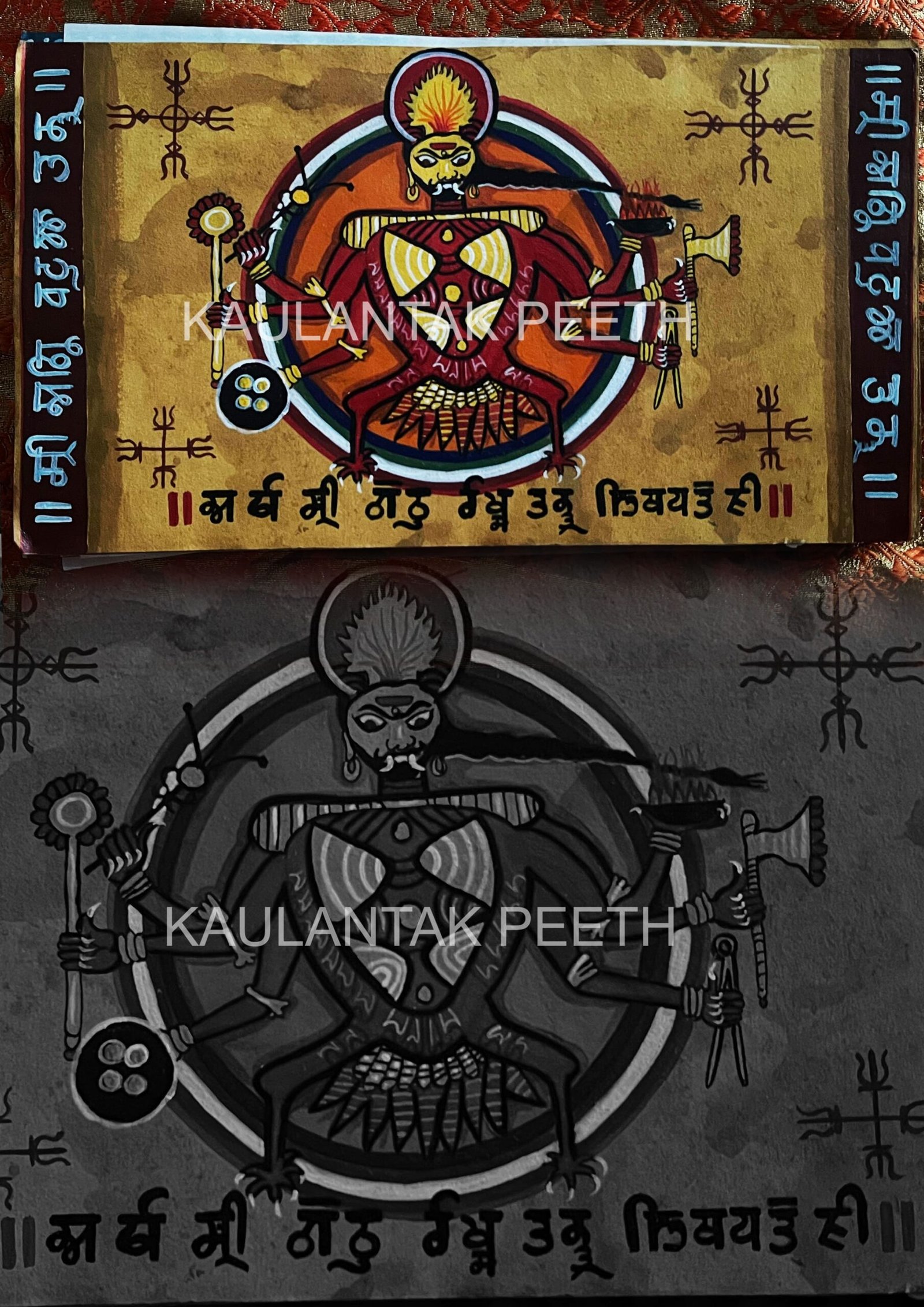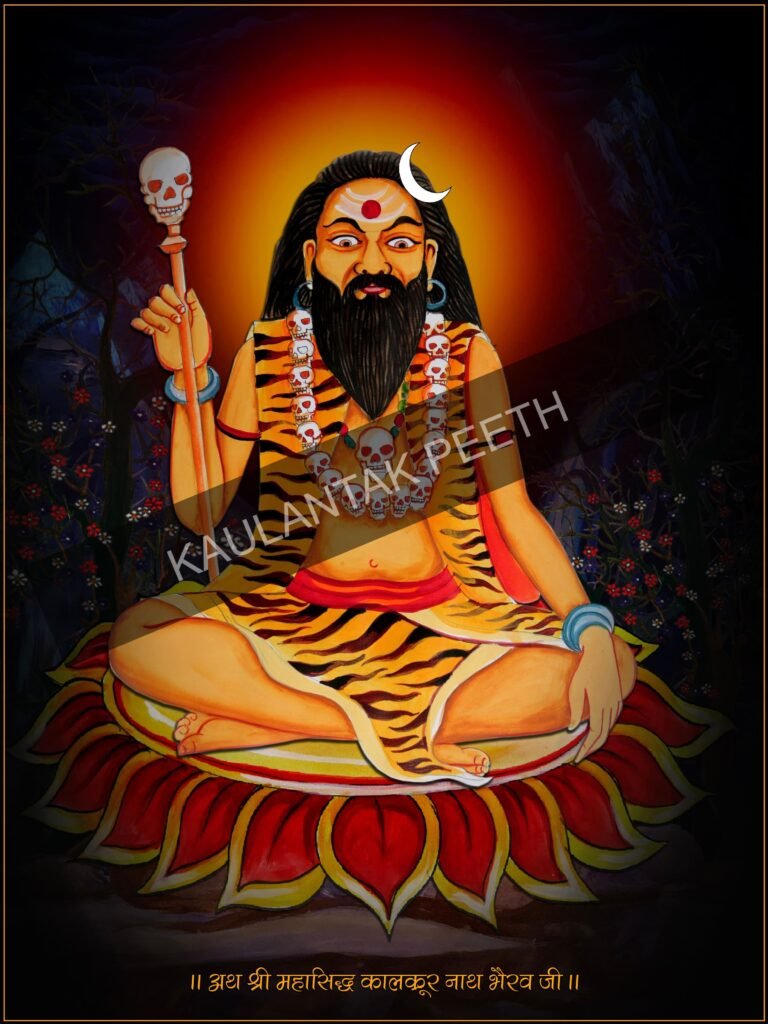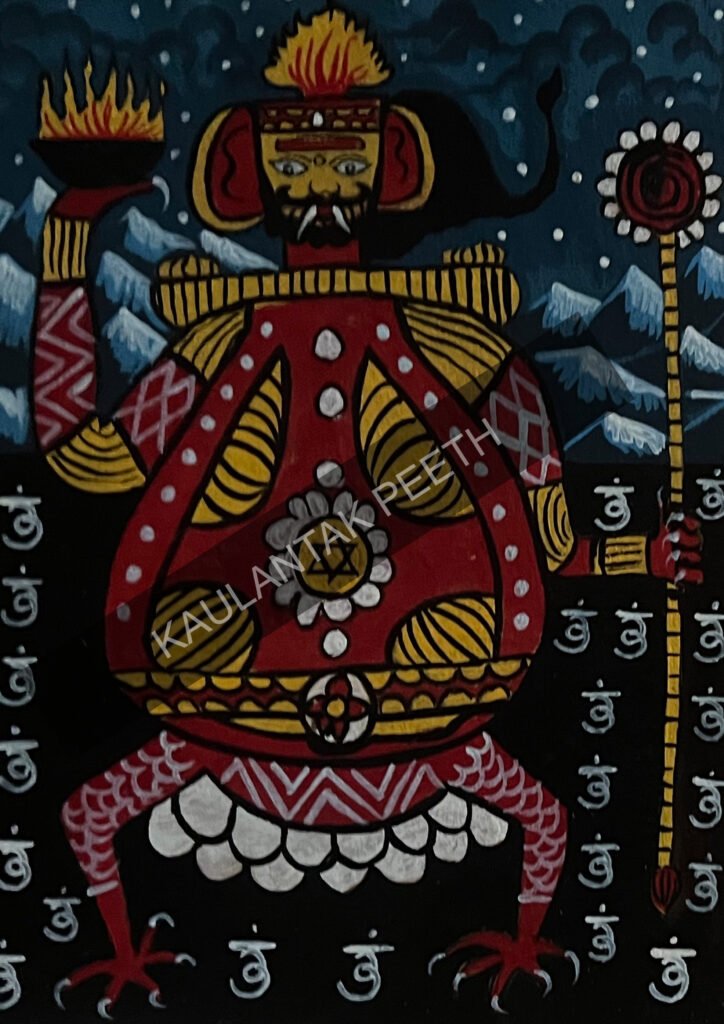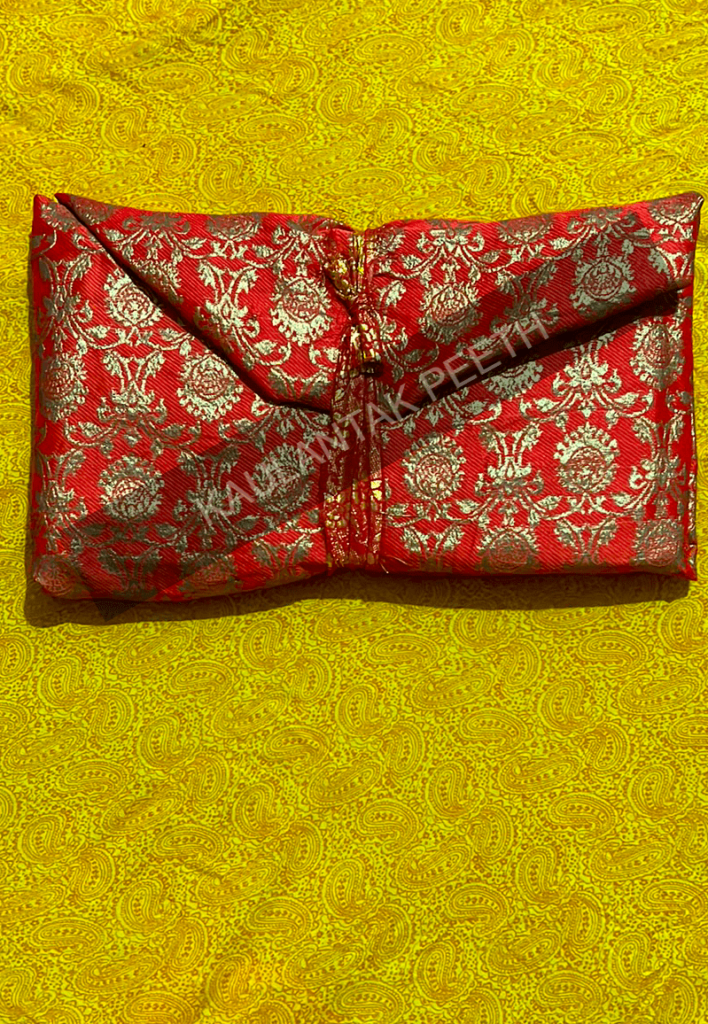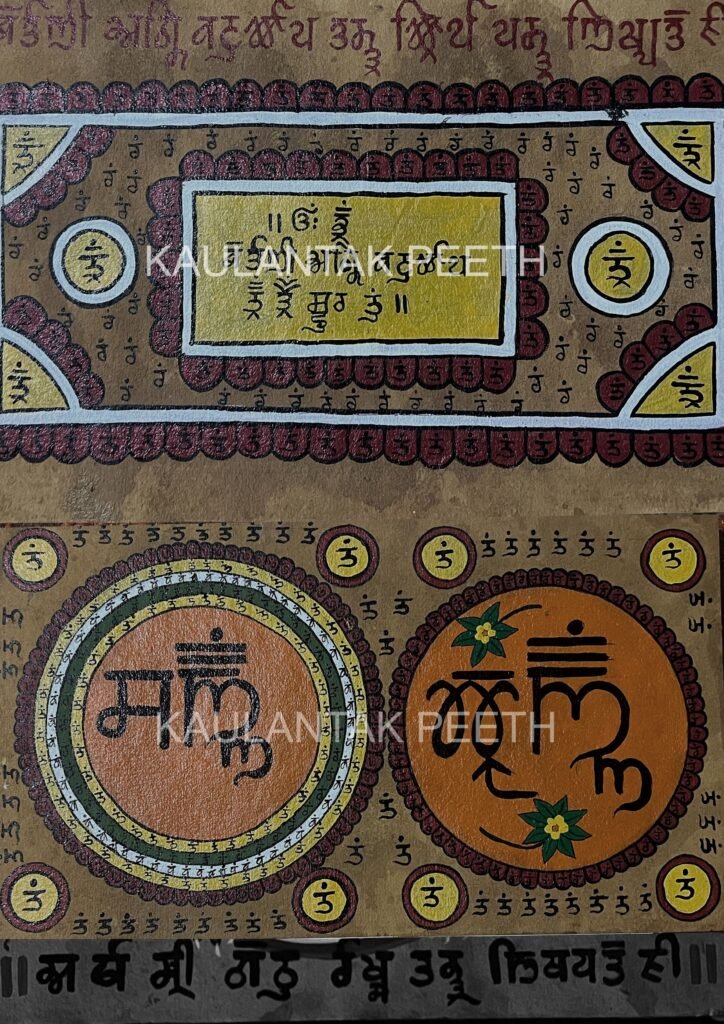‘Agni Batuk Tantra’ is an illustrated manuscript and a Tantra Granth.
‘Agni Batuk Tantra’ is a combination of three words, ‘Agni’ (Sanskrit: अग्नि) means fire, ‘Batuk’ (Sanskrit: बटुक) is the form of Bhairava and ‘Tantra’. The ‘Agni Batuk Tantra’ is a ‘Granth’ that was given by Mahasiddha Kaalkroora Nath to his disciples through ‘Maukhikh Parampara’ (oral tradition of passing on knowledge) in the lineage of Siddha Dharma of the Himalayan Siddhas. He was a Mahasiddha of Kulant Peeth (Kaulantak Peeth), in the lineage of Siddha Dharm. This Tantra Granth was passed on through ‘Maukhikh Parampara’ for many generations of the Mahasiddhas. But later, in the modern history of Kulant Peeth (Kaulantak Peeth), this Granth was handwritten in Kula Bhasha by Pandit Kurmachand (also known as Yogi Kurma Nath) in Tankari script.
The ‘Deshaj’ (the local) name of ‘Agni Batuk Tantra’ Granth is ‘Atha Shri Getthuraksh Tantra Likhyate Ji’ which is written on the cover page, under the Deity figure on it.
This Granth comes under the category of ‘Swaloki Antarikshchara’ which is a part of ‘Antarikshachara Tantra’. ‘Agni Batuk Tantra’ describes the ‘Batuks’, where ‘Batuks’ are known as ‘Getthuraksh’ (local name).
‘Antarikshcahara’ (Sanskrit: अंतरिक्षचर) Antariksh is ‘Akash’ (space) and ‘Chara’ means someone who can move in space. As per Siddha Dharma, the Gods who live and travel in space are worshipped as ‘Antarikshchara’.
Description
‘Shri Agni Batuk Tantram’ has two parts which contains twenty-one ‘Antarikshchara Batuk’ Deity Figures. This is the manuscript of the Siddha Dharm and is written in Black and Red ink in Tankari script. The first part of this Granth manuscript has Deity Figures, description, Mantra of Deity and Yantra of Deities. The second part of the manuscript contains the Shamanic Mantras, Yantras, Mandalas and Shaman rituals. The ‘Agni Batuk Tantra’ manuscript is written on thick hand made paper, totalling 64 pages, with the content of the Granth written on both sides of each page.
As per Siddha Dharma of the Himalayan Siddhas, the manuscripts which become too old, faded and in dilapidated condition (खंडित ) are considered inauspicious (अशुभ ) and cursed (शापित ). So the manuscripts need the retouch work and maintenance from time to time.
The dimension of this manuscript is 290 by 173 mm. Each text page has 7-10 lines of text. The colors of the illustration of the Deity figures were found to be faded. The illustrations were retouched to restore the original colour theme in order to preserve the original colour and clarity of the Deity figures.
History
The ending of this manuscript holds a special importance in terms of the historical facts and places it represents.
The ending of the ‘Agni Batuka Tantra’ manuscript give very important information like many names of the same ‘Peeth’ such as ‘Kula Peeth’, ‘Kulantak Peeth’ and ‘Kaulantak Peeth’. ‘Kulantak Peeth’ has been mentioned as ‘Kaulantak Loka’ full of snow mountain peaks. Apart from this, it is mentioned that in which all places did the Himalayan Siddhas gave the knowledge of this ‘Vidya’ and carried this manuscript. The regions of Nepal, Tri-Garta, Kamru, Bhot, Shri Peeth, Kurma Peeth, Uddayana Peeth, Kirat Peeth, Matsya Peeth, Varaha Peeth.
In the same Granth a noteworthy information is mentioned that this manuscript must be kept away from ‘adharmi’, ‘paapi’ and ‘malechcha’.
The Siddhas have also mentioned the name of Bhagwan Shri Swachchanda Bhairav and Mahamayi Kurukulla Kula. And through this we get to know the information about the ‘maukhikh Parampara’ (oral tradition of passing on knowledge) of Mahasiddha Kaalkroora Nath and the Yogi Kurma Nath. It is clearly mentioned in this manuscript that all the ‘Getthu Raks’ (Agni Batuka Beeras in this manuscript) come under the category of ‘Swaloki Antarikshacharas’. It is also mentioned that they came during the dusk time in the evening.
At the end of this manuscript, it is mentioned that ‘Antarikshachara Vidya Sarvottama’
(अंतरिक्षचरा विद्या सर्वोत्तमा) i.e. the study of the ‘Antarikshchara’ is the finest. It further mentions that the finest of all the fine ‘Vidyas’ is ‘Antarikshacharodyana Siddhi Sutra’. It mentions, “Brahmandodari Devi Pujya (ब्रह्माण्डोदरी देवी पूज्या). Siddhir Bhavatu me Sada’ (सिद्धिर्भवतु मे सदा!), which means Goddess Brahmandodari Devi is worthy of worship. May She always bestow me with Siddhis (perfection).
Contents & Illustrations
This manuscript has twenty-two Deity figures including the Deity Figure illustration on the cover page. The name of the ‘Antarikshchara Batuk’ Deity on the cover page was not found anywhere in the manuscript. According to the head of Kaulantak Peeth (also known as Kulant Peeth), the Kaulantak Nath, Mahasiddha Ishaputra, the name of the ‘Antarikshchara Deity’ on the cover is ‘Kaal Paash Batuk’.
The list of twenty-one ‘Antarikshchara Batuk’ Deities in the ‘Agni Batuk Tantra’ manuscript is as follows:
| SL No. | Sanskrit Name | Local Name |
|---|---|---|
| 1 | Bhayanak Agni Batuk | Bhyalu Getthu |
| 2 | Vyaghra Agni Batuk | Brayaghu Getthu |
| 3 | Sthool Agni Batuk | Tumdi Getthu |
| 4 | Shringi Agni Batuk | Shingee Getthu |
| 5 | Ghantikadhara Agni Batuk | Shegalu Getthu |
| 6 | Shweta Agni Batuk | Doodhi Getthu |
| 7 | Shyam Agni Batuk | Kalo Getthu |
| 8 | Kantak Agni Batuk | Shahi Getthu (‘Shahi’ means porcupine) |
| 9 | Dhundhak Agni Batuk | Dhuindhi Getthu |
| 10 | Trimukh Agni Batuk | Gaharu Getthu |
| 11 | Atipundi Agni Batuk | Dhari Getthu |
| 12 | Bindabhadra Agni Batuk | Bindulu Getthu |
| 13 | Neelakanta Agni Batuk | Neelu Getthu |
| 14 | Chaturbhujh Agni Batuk | kliko Getthu |
| 15 | Kumbhi Agni Batuk | Dhahani Getthu |
| 16 | Betaali Agni Batuk | Janghi Getthu |
| 17 | Preti Agni Batuk | Kyadi Getthu |
| 18 | Vajra Agni Batuk | Ritalo Getthu |
| 19 | Vimukhi Agni Batuk | Titlo Getthu |
| 20 | Kaam Mukhi Agni Batuk | Keli Getthu |
| 21 | Parambhadra Agni Batuk | Bhuaari Getthu |
The pages that have the illustration of the ‘Antrikshchara’ Deity contains the information about the Deity on the right right of each illustration. There are twenty-one pages that contain Yantras (Sacred Geometry) of the ‘Batuk Tantra Kriya Yantra’. Each Yantra illustration spans the full length and breath of the page leaving the borders space on each side with the title of each Sacred Geometry at the top. At the centre of each ‘Yantra’, the Mantra of the respective ‘Agni Batuk’ Deity is written.
There are ‘Jantra’ illustrations in this manuscript. ‘Jantra’ is Yantra like illustrations, which are used to be drawn with a specific ritual and then carried with oneself for manifesting the wish in one’s heart.
There are two ‘Mandalas’ illustrated on one page. With forty-two ‘Mandalas’ dedicated to of the twenty-one ‘Agni Batuks’. There are few more illustrations of different Sacred Geometrical Yantras, each one is different from each other, but are related to the ‘Antrikshchara Deities’ present in this Manuscript.
Text & Script
The manuscript on the ‘Agni Batuk Tantra’ has the text which describes the name of each ‘Antarikshchara Deities’. The text also tells about the category of each Deity according to the specific order, based on the hierarchy related to power of each ‘Agni Batuk’. The ‘Mantra’ of each Deity with the ritual to worship the deities is described in it. The second part of text, in the section on each ‘Antarikshchara Deity’, the ritual, material needed in ritual for the Shamans to heal others is described with the respective Yantras.
The third part of text contains the details of the ‘Jantras’ of each ‘Agni Batuk’. The manuscript of the ‘Agni Batuk Tantra’ is written in ‘Kula Language’, written in Tankari script. All the ‘Mantras’ in this manuscript are written in Sanskrit Language.
Purpose
The purpose of this manuscript is to know about the ‘Antarikshcharas’, the different deities who the Mahasiddhas worship and do their Sadhna to receive the ‘Brahmand Vidya’, knowledge about space and how to explore different celestial bodies. The ‘Antarikshcharas’ are also worshipped and meditated upon, through the specific techniques, to gain the knowledge about the different ‘Lokas’ and ‘Bhuvanas’. Only the Yogis who are dedicated to the purpose of exploring the space and the ‘Akash Mandala’ do their worship and Sadhna. Their Sadhna and worship is not meant for common people or Yogis.
Tradition of Preservation
There is a unique tradition to preserve the sacred manuscripts in the library of Kaulantak Peeth (Kulant Peeth). The manuscripts are considered sacred and are worshipped like a Deity is revered.
They are kept in a dedicated sacred space and are worshipped through a specific worship ritual. The manuscripts in Kaulantak Peeth are worshipped at least once in sixteen days. There is a fixed worship Mantra for their worship ritual. But there are unique Mantras dedicated for specific manuscripts. ‘Agni Batuk Tantra’ is one of those manuscripts for which there’s a specific Mantra for its worship ritual.
Not everyone can conduct these worship rituals. Only the appointed Bhairavs and Bhairavis conduct these rituals of the incredible manuscripts holding the great knowledge that has been passed on in the great lineage of the Himalayan Siddhas of Siddha Dharm.

